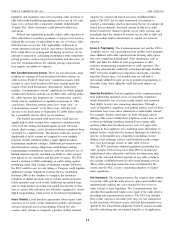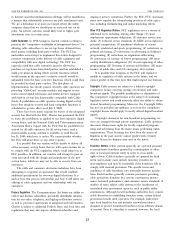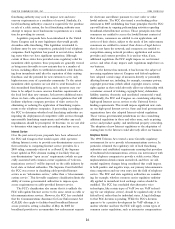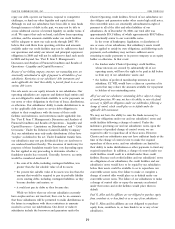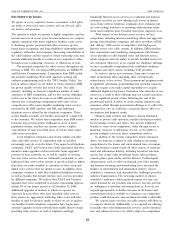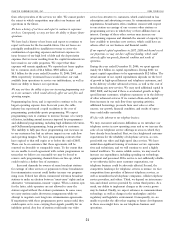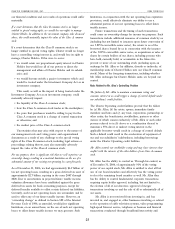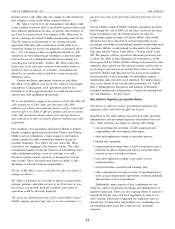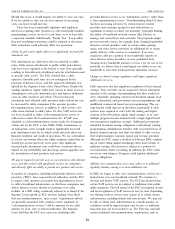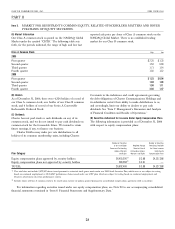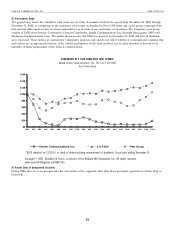Charter 2006 Annual Report Download - page 35
Download and view the complete annual report
Please find page 35 of the 2006 Charter annual report below. You can navigate through the pages in the report by either clicking on the pages listed below, or by using the keyword search tool below to find specific information within the annual report.
CHARTER COMMUNICATIONS, INC. 2006 FORM 10-K
from other providers of the services we offer. We cannot predict service less attractive to customers, which could result in less
the extent to which competition may affect our business and subscription and advertising revenue. In retransmission-consent
operations in the future. negotiations, broadcasters often condition consent with respect
to one station on carriage of one or more other stations or
We have a history of net losses and expect to continue to experience programming services in which they or their affiliates have an
net losses. Consequently, we may not have the ability to finance future interest. Carriage of these other services may increase our
operations. programming expenses and diminish the amount of capacity we
We have had a history of net losses and expect to continue to have available to introduce new services, which could have an
report net losses for the foreseeable future. Our net losses are adverse effect on our business and financial results.
principally attributable to insufficient revenue to cover the If our required capital expenditures in 2007, 2008 and beyond exceed
combination of operating expenses and interest expenses we our projections, we may not have sufficient funding, which could
incur because of our high level of debt and the depreciation adversely affect our growth, financial condition and results of
expenses that we incur resulting from the capital investments we operations.
have made in our cable properties. We expect that these
expenses will remain significant. We reported net losses applica- During the year ended December 31, 2006, we spent approxi-
ble to common stock of $1.4 billion, $970 million, and mately $1.1 billion on capital expenditures. During 2007, we
$4.3 billion for the years ended December 31, 2006, 2005, and expect capital expenditures to be approximately $1.2 billion. The
2004, respectively. Continued losses would reduce our cash actual amount of our capital expenditures depends on the level
available from operations to service our indebtedness, as well as of growth in high-speed Internet and telephone customers, and
limit our ability to finance our operations. in the delivery of other advanced services, as well as the cost of
introducing any new services. We may need additional capital in
We may not have the ability to pass our increasing programming costs 2007, 2008, and beyond if there is accelerated growth in high-
on to our customers, which would adversely affect our cash flow and speed Internet customers, telephone customers or in the delivery
operating margins. of other advanced services. If we cannot obtain such capital
Programming has been, and is expected to continue to be, our from increases in our cash flow from operating activities,
largest operating expense item. In recent years, the cable additional borrowings, proceeds from asset sales or other
industry has experienced a rapid escalation in the cost of sources, our growth, financial condition, and results of opera-
programming, particularly sports programming. We expect tions could suffer materially.
programming costs to continue to increase because of a variety We face risks inherent to our telephone business.
of factors, including annual increases imposed by programmers
and additional programming, including high definition television, We may encounter unforeseen difficulties as we introduce our
and OnDemand programming, being provided to customers. telephone service in new operating areas and as we increase the
The inability to fully pass these programming cost increases on scale of our telephone service offerings in areas in which they
to our customers has had an adverse impact on our cash flow have already been launched. First, we face heightened customer
and operating margins. We have programming contracts that expectations for the reliability of telephone services, as com-
have expired or that will expire at or before the end of 2007. pared with our video and high-speed data services. We have
There can be no assurance that these agreements will be undertaken significant training of customer service representa-
renewed on favorable or comparable terms. To the extent that tives and technicians, and we will continue to need a highly
we are unable to reach agreement with certain programmers on trained workforce. To ensure reliable service, we may need to
terms that we believe are reasonable we may be forced to increase our expenditures, including spending on technology,
remove such programming channels from our line-up, which equipment and personnel. If the service is not sufficiently reliable
could result in a further loss of customers. or we otherwise fail to meet customer expectations, our
Increased demands by owners of some broadcast stations telephone business could be adversely affected. Second, the
for carriage of other services or payments to those broadcasters competitive landscape for telephone services is intense; we face
for retransmission consent could further increase our program- competition from providers of Internet telephone services, as
ming costs. Federal law allows commercial television broadcast well as incumbent local telephone companies, cellular telephone
stations to make an election between ‘‘must-carry’’ rights and an service providers, and others. Third, we depend on interconnec-
alternative ‘‘retransmission-consent’’ regime. When a station opts tion and related services provided by certain third parties. As a
for the latter, cable operators are not allowed to carry the result, our ability to implement changes as the service grows
station’s signal without the station’s permission. In some cases, may be limited. Finally, we expect advances in communications
we carry stations under short-term arrangements while we technology, as well as changes in the marketplace and the
attempt to negotiate new long-term retransmission agreements. regulatory and legislative environment. Consequently, we are
If negotiations with these programmers prove unsuccessful, they unable to predict the effect that ongoing or future developments
could require us to cease carrying their signals, possibly for an in these areas might have on our telephone business and
indefinite period. Any loss of stations could make our video operations.
21





